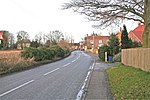Hambleton railway station
Disused railway stations in North YorkshireFormer Leeds and Selby Railway stationsRailway stations in Great Britain closed in 1964Railway stations in Great Britain opened in 1834Use British English from June 2021

Hambleton railway station was a railway station on the Leeds and Selby Railway in North Yorkshire, England. The station was opened with the line in 1834, closed to passengers in 1959 and then to goods in 1964. It was used sporadically in the 1970s as an embarkation point when Selby station was undergoing refurbishment. The site of the station has been partly demolished by a new railway spur built in 1983.
Excerpt from the Wikipedia article Hambleton railway station (License: CC BY-SA 3.0, Authors, Images).Hambleton railway station
Painter Lane,
Geographical coordinates (GPS) Address Nearby Places Show on map
Geographical coordinates (GPS)
| Latitude | Longitude |
|---|---|
| N 53.776 ° | E -1.162 ° |
Address
Painter Lane
Painter Lane
YO8 9HY , Hambleton
England, United Kingdom
Open on Google Maps










